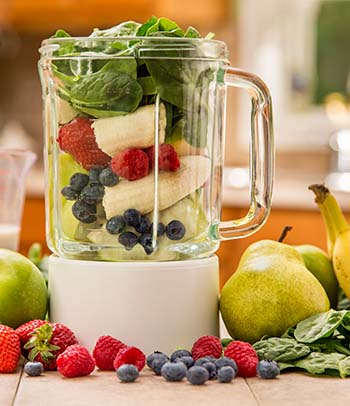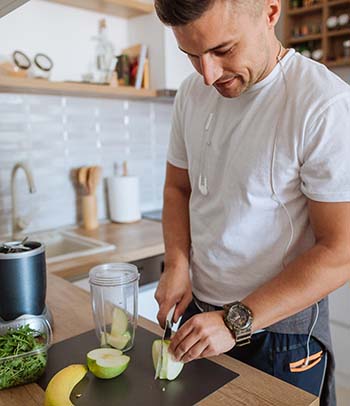If your health and wellness goals have anything to do with adding more protein to your diet or eating more fruits and vegetables, chances are you’ve thought about smoothies as a part of your plan. Smoothies can be a delicious way to incorporate more healthy foods into your diet, but they can also be packed full of added sugar and provide less nutritional value than you assume.
If you want to use smoothies as a part of your diet, check out the info below to make sure you’re making healthy choices.
What Is a Smoothie?
A smoothie made with the right ingredients can be a great way to incorporate healthy foods into your daily diet.
A smoothie is a thick and creamy beverage that’s made in a blender. Often a smoothie contains a liquid base, such as milk or juice, and then combines ingredients such as pureed fruits, vegetables, yogurt, nuts and seeds. Smoothies tend to use either ice or frozen ingredients to create their cold, thick consistency.
Smoothies can be modified to meet your nutritional goals and your preferred tastes. Popular ingredients include:
- Fruits (berries, bananas, apples, peaches, mango, etc.)
- Vegetables (greens like kale or spinach, avocado, carrots, beets, etc.)
- Nuts and seeds (almond butter, peanut butter, chia seeds, flax seeds, walnuts, almonds, etc.)
- Spices (ginger, turmeric, parsley, etc.)
- Liquid (water, milk, nondairy milk, cold brew coffee, fruit juice, etc.)
- Additional nutritional supplements (matcha powder, protein powder, etc.)
- Other ingredients such as sweeteners (maple syrup, raw sugar, honey, etc.) and thickeners (yogurt, oats, cottage cheese, etc.)
What Are the Health Benefits of a Smoothie?
 A smoothie made with the right ingredients can be a great way to incorporate healthy foods into your daily diet. Here are some potential benefits:
A smoothie made with the right ingredients can be a great way to incorporate healthy foods into your daily diet. Here are some potential benefits:
- Increased intake of fruits and vegetables – Studies show that eating the recommended number of fruits and vegetables reduces your risk of chronic conditions such as diabetes, heart disease and inflammation. But according to the U.S. Department of Agriculture (USDA), 75% of people have dietary patterns that are too low in fruits and vegetables. If you’re not hitting the target, a smoothie can be a great way to add more to your diet.
- Increased fiber intake – Getting the recommended amount of fiber can aid your body with digestion, help you build a healthy gut and reduce your risk for chronic disease. The USDA notes that most people are not getting the recommended amount of fiber per day. Many fruits and vegetables are packed with fiber.
- Increased dairy intake – If you’re making your smoothie with milk or yogurt, you can add important vitamins such as calcium and vitamin D to your diet, both of which can help maintain and strengthen your bones.
- Increased protein intake – Adding Greek yogurt, nut butter or protein powder to a smoothie can be a great way to increase the amount of protein you get each day. This can be important for different groups of people such as pregnant women, vegetarians, older adults and more.
How Can I Make Sure My Smoothie Is Healthy?

A smoothie is only as healthy as the ingredients you put in it. If it’s packed with added sugar and sweeteners, it’s not giving you the health benefits you may imagine. Here are a few tips to help you get the most out of your favorite smoothies:
- Read the label if you’re buying a premade smoothie. How many calories does it contain? How many grams of sugar? A quick search online showed smoothie companies with menus that included smoothies with 57 grams of added sugar and total calorie counts above 700. However, some of those same companies offered smoothies that contained no added sugar and less than 300 calories. Always check nutrition information and ingredients before making your selection.
- Think about the smoothie’s purpose. Is it a meal replacement? A snack between meals? A treat (more like a milkshake)? Determine why you’re having the smoothie to ensure it meets your health goals.
- Find ways to sweeten your smoothie in a healthy way. Sure, adding syrup or honey to a smoothie will make it taste sweet, but those sweeteners can add a lot of extra calories and grams of sugar. Consider a ripe banana, mango or berries to add some healthy sweetness.
- Know your ingredients. Sometimes added sugar is easy to spot, like if a recipe calls for a ¼ cup of honey, but what about the other ingredients you’re adding? Sometimes we don’t bother checking things like fruit juice, fruit-flavored yogurts or our protein powders, but these ingredients can contain a lot of added sugar.
- Measure out your ingredients when you start. This can seem tedious, but it’s important to know how many servings of things you’re actually adding to your smoothie.
- Talk to your health care provider. If you’re dealing with a chronic disease, such as diabetes that can make sugar problematic, talk over a good smoothie recipe with your health care provider. Certain fruits have a lot of sugar and you may not be able to add many more to your diet.
What Are Some Healthy Smoothie Recipes to Try?
The Department of Veterans Affairs offers a few smoothie recipes for you to try, including a strawberry-banana oatmeal smoothie. The USDA offers a basic fruit smoothie recipe that you can adapt to meet your nutritional goals, as well as a green smoothie and a breakfast smoothie which both contain fruits and greens to get your day going. MedlinePlus offers this power smoothie which sneaks in 2 cups of spinach.
In addition to these recipes, you can search online for more ideas. You can add words to your search to match your goals such as “smoothies with lots of vegetables” or “smoothies with added protein.” There is no shortage of recipes out there.
Once you’ve tried a few different recipes and start getting confident, make your own! You can visit USDA’s guidelines for a healthy diet and see if you can incorporate more of what you need into your daily smoothie.







